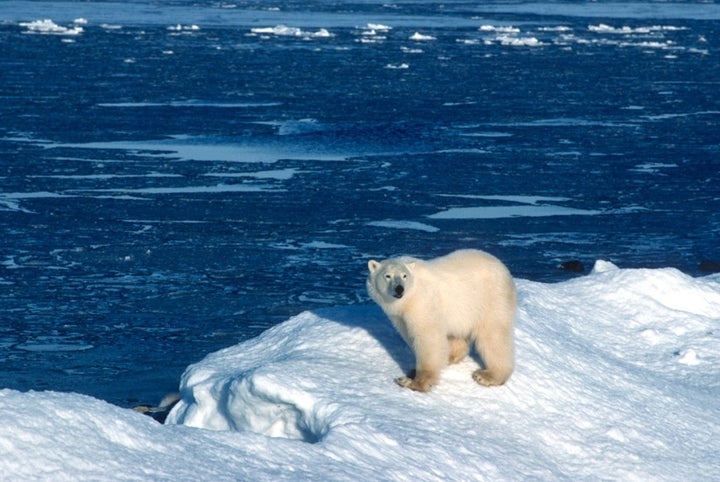
Because polar bears depend on a sea ice habitat that literally melts as temperatures rise, they have become a target of global warming deniers. These contrarians loudly claim, without evidence, that the bears are fine. But the data shows otherwise.
Mark Twain was prescient when he said, “A lie can travel halfway around the world while the truth is putting on its shoes.”
Twain understood that, because lies don’t require proof, they can be packaged as simple sound bites and spread more quickly than evidence-based truths. Twain also understood what Blaise Pascal concluded in the 17th century: that people tend to form their beliefs based on what they find attractive rather than what the evidence shows. Hence, most of us are primed to believe statements that sound good—even if they aren’t true.
Twain, however, couldn’t have imagined our current electronic world, in which someone with money or position could tweet that “global warming is a hoax” and people would believe it. Neither could he have imagined millions would re-tweet such a lie or that it could overcome decades of evidence to the contrary—while denial of the problem is, in fact, the hoax.
Because polar bears depend on a sea ice habitat that literally melts as temperatures rise, they have become a target of global warming deniers. By falsely claiming polar bears will be fine—and taking information about the bears out of context—these contrarians hope to cast doubt on global warming threats and the urgent need to take action. But they lack evidence to support their claims.
What Does the Science Show?
I’ve studied polar bears most of my adult life, and have added greatly to our understanding of the bears and the threats they face. The evidence that my colleagues and I have collected, clearly shows that polar bears rely on sea ice to catch their seal prey. All available evidence confirms Earth is warming due to increasing greenhouse gas concentrations, and that warming is melting the sea ice. It is clear, therefore, we must halt greenhouse gas rise if we want to save polar bears.
In 2007 my research team and I presented our findings to U.S. Secretary of the Interior Kempthorne; the evidence convinced him to designate polar bears as a threatened species. Ten years on, however, we have done little to protect polar bears, and their sea ice habitat has continued its precipitous decline. Yet, internet and social media claims, made without evidence, wrongly suggest that sea ice is recovering and global polar bear numbers may even be growing. Worse yet, our government’s leaders have falsely stated that global warming may not be real(!) and that “there is too much uncertainty to take action.”
Nothing could be further from the truth. Of course, there still are uncertainties about some impacts of warming. But we understand the driving forces of human-caused global warming as well as we understand gravity. There still are details regarding gravity that we don’t fully understand, but we don’t doubt for a second that if we miss a step we’ll fall down the stairs! Likewise, we know that the world can only continue to warm and more ice must melt as long as greenhouse gas concentrations rise.
Denying global warming and the threats it poses for polar bears, is, as science writer Michael Specter says, “rejecting obvious truths for more comfortable lies.” Discerning the truth, of course, goes way beyond polar bears, and gets to the core of how we understand, respond to, and indeed manage our world. But with so much misinformation out there, how do we recognize the truth?
Separating Fact from Fiction
In their insightful essay, The World at Our Fingertips, Stuart Pimm and Jeff Harvey offer a set of basic guidelines to assess what we hear and read:
Follow the data. Is the statement supported by evidence or does the data trail go quickly cold?
Follow the credentials. Have the authors/speakers done any research or other work to establish expertise in the subject? Do they cite peer-reviewed sources?
Follow the language. Do the authors/speakers substitute personal attacks and sweeping statements for data and analysis?
Follow the money. Who is paying for that statement; what may they have to gain by doing so?
With the constant bombardment we now face in electronic media, these guidelines are ever more important in helping us separate evidence-based truths from unsubstantiated opinions and lies. We live in an amazing era, where we can dive into any subject with a few mouse clicks. But we need to remember that words are not necessarily information and just because a statement is comforting doesn’t mean it is true. If we really care about the world we’re leaving our children, we must be wary of letting ourselves be swayed by lies that may appeal to our wishes for the world rather than recognizing how the world really is.
It may be comforting to believe human activities are not warming the planet or that polar bears are not threatened with extinction. But the evidence shows both claims are false. We’ve long known what we need to do to ensure a future for polar bears. If we stop atmospheric greenhouse gas rise we can stabilize sea ice and prevent polar bears from disappearing over much of their range. The evidence also is clear that if we act in time to save polar bears, we’ll benefit the rest of life on Earth, including ourselves. And, that is how the world really is!
Dr. Steven C. Amstrup is the chief scientist at Polar Bears International.
